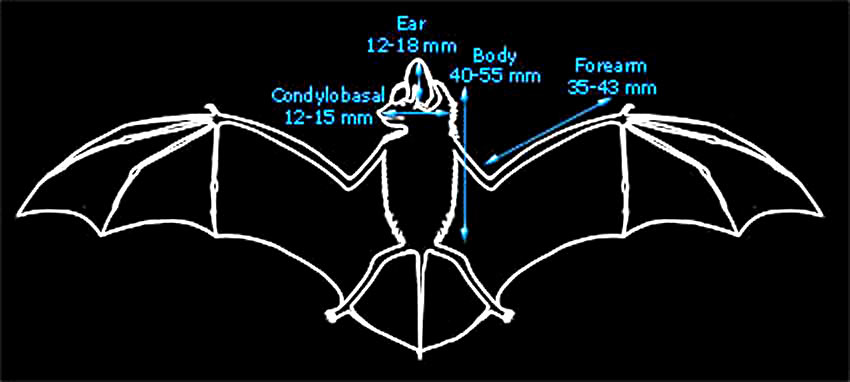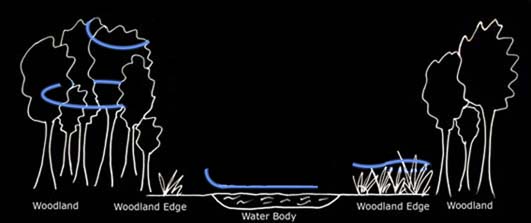Morphological Description
Life History
Distribution
Habitat
Roost Sites and Roosting Patterns
Emergence and Flight Pattern
Foraging Behaviour
Echolocation Calls
Status and Protection |
|
|
Morphological Description
- Dorsal fur is black-brown. Ventral fur is dark grey.
- Juveniles are darker than adults.
- Ears are joined on the top of the head, distinguishing the barbastelle from all other British bat species.
- The tragus is large and triangular.
- Average weight (as given by Greenaway & Hutson, 1990) 6-13 g.
The diagram below gives important average body measurements for barbastelles (Greenaway & Hutson, 1990).
|

Back to top |
Life History
- Mate in the autumn and in winter roosts.
- One young is born from mid-June.
- Maximum age recorded in Europe is 23 years (Schober & Grimmberger, 1989).
Back to top
|
Distribution |
|
|
 |
| The British and World distributions are shown by the white areas of the maps above (as given by Richardson, 2000 and Corbet & Harris, 1991 respectively). |
|
- Widespread over Britain but rare.
- Maternity roosts found in several areas including Somerset, Wales, Hampshire, south-east England and Devon.
Back to top
|
Habitat |
|
- Wooded river valleys and occasionally meadows.
- Also areas of human occupation.
- The photograph on the left shows a typical habitat of barbastelles.
|
| Roost Sites and Patterns |
- Summer roosts: trees, especially under bark and cracks in storm damaged trunks, roof spaces, tree holes.
- Russo et al. (2004) found that barbastelles in central Italy show a preference for tree roosts in unmanaged forests and avoid open woodland and pasture. Dead beech trees were preferred, as were taller trees. Dead and mature trees should therefore be left when logging areas used by barbastelles. This is particularly important because barbastelle bats are likely to need a large number of trees as they have small colony sizes and often switch roosts.
- Winter roosts: generally trees or buildings, occasionally colder areas of caves and cellars.
- 10-20 females are typically found in nursery roosts. Males are solitary during the summer.
- Switch roosts frequently.
- Roosts are sensitive to disturbance.
Back to top
|
Emergence and Flight Pattern |
- Emerges in early dusk and often in light.
- Active sporadically
throughout the night.
- Flight is low, normally
over water and not particularly agile.
- Flight is fast in between periods of hunting.
Back to top
|
Foraging Behaviour |
|
Forages along woodland edges at treetop height and low over water.
The diet of barbastelles consists almost exclusively of Lepidoptera, probably caught by aerial hawking.
Some other prey items,
such as spiders,
may be gleaned (Vaughan, 1997).
Work by Sierro and Arlettaz (1997) found that 99% of the diet of barbastelles in the Swiss Alps consisted of Lepidoptera, mainly tympanate moths. The barbastelle uses an unusual method of aerial foraging, flying just above the forest canopy. This foraging behaviour may be adapted
specifically to tympanate moths.
A study of the barbastelle diet in Germany and Switzerland by Rydell et al. (1996) found that 73-94% of the diet was lepidopteran. This differs from other European bats in that there were nearly no dung beetles or midges found. The consideration of moth population levels is therefore especially important when considering barbastelle conservation.
|
 |
|
Marked in blue on the diagram above is a typical foraging path of barbastelles (based on Russ, 1999).
Back to top
|
Echolocation Calls |
|
|
 |
The echolocation call of barbastelles is frequency modulated. |
|
To listen to the call of the barbastelle click here
Size of sound file: 14.1 KB
For details of how the echolocation calls were recorded click here.
|

|
|
Average values for a barbastelle echolocation call, as given by Vaughan et al. (1997), are listed below:
Interpulse interval: 63.8ms
Call duration: 4.4ms
Minimum frequency: 28.4kHz
Maximum frequency: 46.0kHz
The spectrogram on the left shows clear frequency modulation, with the call beginning at high frequency and ending at a lower frequency.
The power spectrum on the left shows that the maximum power of the call is at a frequency of approximately 56 kHz.
|
Back to top
|
|
| Status and Protection
- Rare in Britain.
- The British pre-breeding population was estimated at 5000 in 1995 (4500 in England, 500 in Wales) (Harris et al., 1995).
- The worldwide IUCN status (2001) for barbastelle bats is Vulnerable.
- Reasons for population decline are unclear, could possibly be due to the use of insecticides resulting in declining prey levels.
- Protection of known habitats and nursery roosts can be used to help maintain existing populations.
- Barbastelles are extremely rare in Britain, with just five colonies identified in 2001 (Greenaway, 2001). One colony of these colonies is in West Sussex and has been continuously studied since its discovery in 1996/97. This colony has a clear roosting pattern that changes throughout the year. In winter the barbastelles roost in large hollow trees surrounded by a dense holly understorey. In spring and autumn they are found beneath loose tree bark or in small cracks. The more open spring and autumn roosts leave the basbastelle more exposed to changes in the microclimate. It is therefore essential that a variety of roost sites are available so that the barbastelle can the site with the best conditions on a daily basis. The dense holly understorey helps to protect the bats from changes in temperature and humidity. Barbastelles also forage in this dark understorey earlier in the evening when open spaces are too light for them to use. This is thought to give the bats up to two hours of extra foraging time each night. The variety of roost site needed by barbastelles are typically found in ancient, complex woodlands but these are now rare in Britain. Loss of barbastelle populations from several areas in south-east England appear to be related to the loss of old woodlands from these areas. An increase in the intensification of farming in these areas may also have contributed to this loss. It is therefore essential that areas with suitable roost sites, such as large unmanaged ancient or semi-natural woodland, are conserved to prevent the loss of other barbastelle populations.
Back to top
|
 © School of Biological Sciences, University of Bristol 2005. Last modified 24th February 2005. © School of Biological Sciences, University of Bristol 2005. Last modified 24th February 2005. |





 © School of Biological Sciences, University of Bristol 2005. Last modified 24th February 2005.
© School of Biological Sciences, University of Bristol 2005. Last modified 24th February 2005.